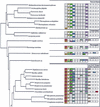The phylogenetic distribution of bacterial ribonucleases
- PMID: 12490701
- PMCID: PMC140075
- DOI: 10.1093/nar/gkf691
The phylogenetic distribution of bacterial ribonucleases
Abstract
Ribonucleases play key, often essential, roles in cellular metabolism. Nineteen ribonuclease activities, from 22 different proteins, have so far been described in bacteria, the majority of them from either Escherichia coli or Bacillus subtilis. Here we examine the phylogenetic distribution of all of these ribonucleases in 50 eubacterial and archaeal species whose genomes have been completely sequenced, with particular emphasis on the endoribonucleases. Although some enzymes are very highly conserved throughout evolution, there appears to be no truly universal ribonuclease. While some organisms, like E.coli, have a large selection of ribonucleases, many with overlapping functions, others seem to have relatively few or have many that remain to be discovered.
Figures



References
Publication types
MeSH terms
Substances
LinkOut - more resources
Full Text Sources
Molecular Biology Databases

